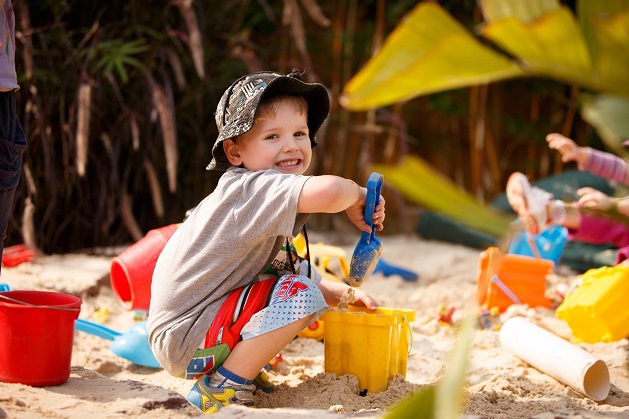Playing with sand, just like playing with water, is entertaining and soothing and offers many developmental benefits for children. Although sand is often associated with the beach, not all parents can afford daily trips to the seaside. But this does not mean you have to deny your children the pleasure of creating sand castles; you can easily bring the beach to your backyard or patio with a sand pit.
Sand Pit Buying Guide
Sand pits come in a variety of traditional and unique designs as well as in various shapes and sizes. So, which childrens sand pits will best suit your budget and your kids’ needs?

The larger sand pits are often made from per-treated wood meaning they can stay outside all year round without the need of special maintenance, but they also cost more. Smaller models are most often made of plastic (which can be molded into various shapes) and are budget friendly. Many childrens sand pits also come with a protective cover (to prevent sand from getting wet and to prevent contamination by animals when the sand pit is not in use) and even with a canopy to protect your children from UV rays. Also, consider the size of the sand pit. Invest in a larger one so your kids can use it for years, plus your kids will have more imaginative fun.
Sand pits usually come without sand. It is best to buy play sand to ensure the safety of your children. While construction sand is easy and cheap to obtain, it may be contaminated with chemicals that can pose danger to your kids. Although investing in play sand may seem a bit expensive, knowing the sand is safe for your little ones is well worth the cost.
Sand Pit Games to Explore
Playing with sand is the perfect activity for babies and toddlers to explore texture and learn the concept of full and empty. For kids between 3 and 5 years old, sand pits are perfect for developing motor, problem-solving and communication skills as well learning to socialize and share things with other children.
Hide and Find
Bury a coloured object or a small toy in dry or wet sand and have your little one search for it. Make sure you do not leave your baby or toddler playing this game alone as small objects are basially a potential choking hazard.
Lines and Patterns
Wet sand is a great way to develop artistic skills. You can draw patterns in the sand with your finger or a stick and then encourage your children to do the same.
Sock Heads
Old, large socks are a great way for children between 3 and 5 years to interact with sand. Kids can fill a sock with sand, tie off the top (with your help of course) and try to mold the sock into different shapes.
Sand Village
Building a sand village is a great outdoor game for a group of small children. Give each kid a bucket and a shovel and encourage them to work together to build sand houses, stores, schools, etc. This game can also teach creativity and encourage teamwork.

